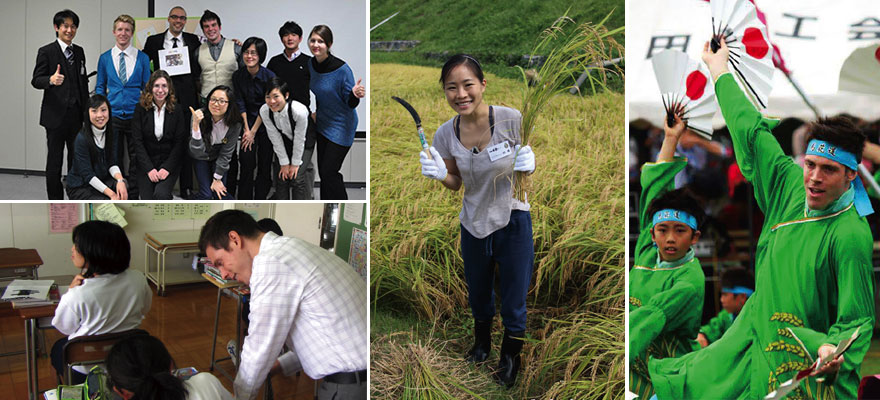Home > Highlighting JAPAN > Highlighting Japan October 2013 >Japanese Globalization
Highlighting JAPAN
Japanese Globalization
JET Program
Communicating with Japanese students through the joy of teaching

MOST Japanese know of foreigners mainly in public schools helping the students with English learning. What they might not know is that most of these foreigners have been dispatched through the Japan Exchange and Teaching Program, or the JET Program. JET has recruited more than 58,000 young people from 63 different countries to come to Japan over the last 27 years. While most of them hail from English-speaking countries such as the US, Canada, the UK, Ireland, Australia, and New Zealand, in 2013, JET welcomed over 4,000 participants from 40 countries including people whose employment contracts were extended.
JET program is administered by The Council of Local Authorities for International Relations (CLAIR). The project is also cooperated by the following Japanese government ministries: Ministry of Internal Affairs and Communications, Ministry of Foreign Affairs, and the Ministry of Education, Culture, Sports Science and Technology. Local government organizations are also fundamental to the operation of the program. Its main purpose is to promote internationalization by inviting young people to assist in exchange programs and foreign language education in local governments, boards of education, and schools throughout Japan. It seeks to foster ties between Japanese citizens and JET participants at the person-to-person level.
What's interesting is that fluency in languages is not stated as a goal; in fact, participants are not expected to make their students fluent, but rather to contribute toward a positive learning experience so that students will feel more receptive about learning foreign languages and socializing with foreigners now and in the future.
We talked to Zack Robertson, from Texas in the USA. Zack worked as an ALT near Fukuoka from 2005 to 2010. ALT is short for Assistant Language Teacher. ALT's mother tongues are English but in some cases, languages other than English, however, they work as assistants in teaching English as a foreign language.ALTs work at elementary, junior high schools and high schools to teach students English pronunciation and international studies. Zack is married to a Japanese National, and they now have a three-year-old daughter. Still teaching English as a job even after the end of his JET contract, he said, "I try to incorporate cultural elements into my lessons whenever possible. Eating lunch with the kids every day allows me to interact with them in a more informal setting and to answer their various questions regarding my country and the world in general."
Heading further north, Christine Maeda, a CIR (Coordinator of International Relations) currently resides in Himi City, which faces the Sea of Japan in Toyoma Prefecture. Christine begins her day with the English phrase "Good morning" and a bright smile. CIRs are mainly attached to international exchange divisions in local public bodies and engage in international interchange. Although Christine's parents are originally from Japan, she grew up in Torrance, California, and rediscovered her roots at high school. Having graduated with a degree in English, she is enjoying teaching English and culture, communicating with local people, and her ongoing search for the self while a member of the JET Program.
Christine said, "Attention to detail and excellent hospitality are some aspects of Japanese culture that should be imported to America."
Venturing further north again, 32-year-old David Flynn works as an ALT for schoolchildren at Towada City, Aomori Prefecture. He is one of a growing number of JET participants who joined the program in their 30's. His motivation for making the leap from a stable job in Canada was the desire to experience living abroad and a deep rooted passion for Japan.
He certainly got somewhere abroad.
David commented, "When I first got here, I couldn't read any Japanese!" Since arriving two years ago, he has worked hard learning Japanese. He stresses the need to focus on communication and "having fun through learning" in his teaching. He maintains this idea in his extracurricular activities such as teaching a group of 115 children how to hip-hop dance and winning a yosakoi (traditional Japanese dance) competition with his team in Aomori City.
All things come to an end though, and for those teachers who return home, the JET Alumni Association, which is run by ex-JET program participants, promotes understanding of Japanese culture around the world through classes like Japanese cooking, language, ikebana (Japanese flower arrangement), tea ceremony, and wadaiko (Japanese percussion instruments). After the disastrous earthquake and tsunami in 2011, many alumni have donated much time and money to relief and rebuilding efforts.
With such a large number of teachers passing through the program, the JET program has been a tremendous success. Mixed international families, overseas cultural events, return visits to postings years later, and lifelong long-distance friendships, are all evidence of the lasting goodwill, energy, and dreams that the program has created.
© 2009 Cabinet Office, Government of Japan






